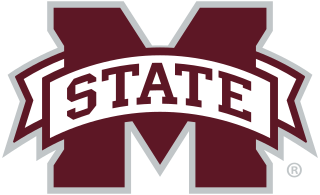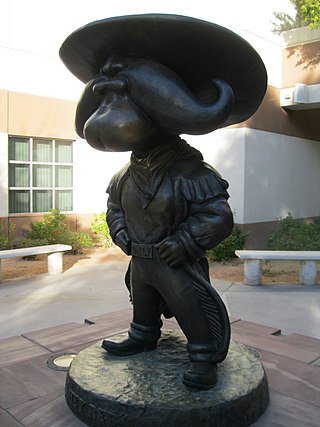
The University of Mississippi is a public research university that is located adjacent to Oxford, Mississippi, and has a medical center in Jackson. It is Mississippi's oldest public university and it is the second largest by enrollment.

The Egg Bowl is the name given to the Ole Miss–Mississippi State football rivalry. It is an American college football rivalry game played annually between Southeastern Conference members Mississippi State University and Ole Miss.

Vaught–Hemingway Stadium at Hollingsworth Field is an outdoor athletic stadium located in University, Mississippi, United States. The stadium serves as the home for the University of Mississippi Rebels college football team. The stadium is named after Johnny Vaught and Judge William Hemingway. Since its expansion in 2016, it is the largest stadium in the state of Mississippi with a capacity of 64,038 and also holds the state record for attendance at 66,703.

The Ole Miss Rebels are the 18 men's and women's intercollegiate athletic teams that are funded by and represent the University of Mississippi, located in Oxford. The first was the football team, which began play in 1893.

C. M. "Tad" Smith Coliseum is an 8,867-seat multi-purpose arena on the campus of the University of Mississippi. Through the first part of the 2015–16 basketball season, it was home to the University of Mississippi Rebels men's and women's basketball teams, but was replaced by a new arena, The Sandy and John Black Pavilion, in January 2016. It has also hosted many concerts, including Widespread Panic in September 1995 and The Allman Brothers with Gov't Mule in November 1995.

Frank Manning "Bruiser" Kinard Sr. was an American football tackle and coach and university athletic administrator. He was inducted into the College Football Hall of Fame as a charter member in 1951 and into the Pro Football Hall of Fame in 1971.

Big Al is the costumed elephant mascot of the University of Alabama Crimson Tide in Tuscaloosa, Alabama.

The Ole Miss Rebels football program represents the University of Mississippi, also known as "Ole Miss". The Rebels compete in the Football Bowl Subdivision (FBS) of the National Collegiate Athletic Association (NCAA) and the Western Division of the Southeastern Conference (SEC). The Rebels play their home games at Vaught–Hemingway Stadium on the university's campus in Oxford, Mississippi.

The 2009 Ole Miss Rebels football team represented the University of Mississippi during the 2009 NCAA Division I FBS football season. The team was led by Houston Nutt, who was in his second season as the Rebels' head coach. Ole Miss has been a member of the Southeastern Conference (SEC) since the league's inception in 1932, and has participated in that conference's Western Division since its formation in 1992. The Rebels played their seven home games in 2009 at Vaught–Hemingway Stadium in Oxford, Mississippi, which has been Ole Miss football's home since 1915. The Rebels finished the season 9–4, 4–4 in SEC play and won their second straight Cotton Bowl Classic 21–7 against Oklahoma State.

Rebel, The Black Bear was the mascot of the Ole Miss Rebels, the collegiate athletic teams of the University of Mississippi. The anthropomorphic black bear replaced Colonel Reb as the official mascot in 2010. On October 6, 2017, Chancellor Jeffrey Vitter announced that the new university mascot would be the Landshark, beginning with the 2018–19 season. Rebel's design would later be recycled for Joe Bear, the mascot of the Lenoir-Rhyne University in late 2019.
The Bud Light Daredevils were an American acrobatic basketball show that performed during the halftime of college and NBA basketball games from 1983 to 1998. The show combined gymnastics, trampoline, acrobatics, and basketball. The team was started by University of Mississippi cheerleaders Ty Cobb, Sam Martin, Robert Kirby, Tyler Hubbard, John White, and Ty Cobb's younger brother Guy Cobb.

Bully is the official mascot of the Mississippi State University Bulldogs in Starkville, Mississippi, and the name is given to both the costumed mascot and the live bulldog that appears at State games. The live mascot Bully is an American Kennel Club registered English Bulldog, and each dog is given the inherited title of "Bully". The name "Bully" is traditionally considered a title and not the official name of the specific dog that holds it.

Hey Reb! was a mascot for the UNLV Rebels, the athletic teams of the University of Nevada, Las Vegas in Paradise, Nevada, USA. He performed live at all UNLV athletic events. The mascot, Hey Reb!, was first created in 1983 to depict the embodiment of an independent, rebel spirit at UNLV athletic events, intended as a tribute to western settlers.

The 1962 Ole Miss Rebels football team was an American football team that represented the University of Mississippi in the Southeastern Conference (SEC) during the 1962 NCAA University Division football season. In their 16th year under head coach Johnny Vaught, the Rebels compiled a perfect 10–0 record, outscored opponents by a total of 247 to 53, won the SEC championship, and defeated Arkansas in the 1963 Sugar Bowl. To date, it is the only undefeated and untied season in Ole Miss football history.
The 1974 Ole Miss Rebels football team represented the University of Mississippi in the 1974 NCAA Division I football season. The Rebels were led by first-year head coach Ken Cooper and played their home games at Hemingway Stadium in Oxford, Mississippi and Mississippi Veterans Memorial Stadium in Jackson. The team competed as a member of the Southeastern Conference, finishing in last. The Rebels opened the season with an upset of Missouri, but the rest of the season went very poorly, as the team went winless in conference play and finished with a record of 3–8, the school's first losing season since 1949.
The 1980 Ole Miss Rebels football team represented the University of Mississippi as a member of the Southeastern Conference (SEC) during the 1980 NCAA Division I-A football season. Led by third-year head coach Steve Sloan, the Rebels compiled an overall record of 3–8 with a mark of 2–4 in conference play, and finished seventhin the SEC. Ole Miss played home games at Hemingway Stadium in Oxford, Mississippi and Mississippi Veterans Memorial Stadium in Jackson, Mississippi.
The 1981 Ole Miss Rebels football team represented the University of Mississippi as a member of the Southeastern Conference (SEC) during the 1981 NCAA Division I-A football season. Le by fourth-year head coach Steve Sloan, the Rebels compiled an overall record of 4–6–1 with a mark of 1–5–1 in conference play, placing ninth in the SEC The season opened with a close win over Tulane.
"From Dixie with Love", also known as "Slow Dixie", is an American song combining elements of "Dixie" and the "Battle Hymn of the Republic". It was created and predominantly performed as the fight song at the University of Mississippi. In 2009, Chancellor Dan Jones asked the university's The Pride of the South marching band to stop playing "From Dixie with Love" at university sports events. According to some alumni and current students, it is now banned from being played in public.
Tony the Landshark, an anthropomorphic shark, is the mascot of the Ole Miss Rebels, the collegiate athletic teams of the University of Mississippi. It replaced Rebel Black Bear as the mascot in fall 2018.

The history of the University of Mississippi, the first public institution of higher education in Mississippi, began in 1844, when the Mississippi Legislature chartered the university. Construction of the university was completed in the rural town of Oxford in 1848.

















